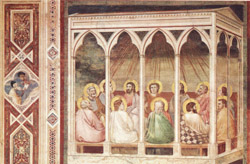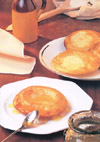|
|
Apartments in Florence, Perugia, Rome, Sorrento and Positano |




|
|
|
|
- You are in: Home » musei » SCROVEGNI CHAPEL - Padua
SCROVEGNI CHAPEL - Padua

The Cappella degli Scrovegni in Padua contains a fresco cycle by Giotto that is one of the most important masterpieces of Western Art. The chapel is dedicated to the Virgin Mary Annunciate and the Virgin of Charity. Giotto's fresco cycle focuses on the life of the Virgin and celebrates her role in human salvation. The chapel is also known as the Arena Chapel because it was built on the site of a Roman arena. The building was completed in 1303 and Giotto's frescoes around 1305.
Enrico Scrovegni of Padua, ambitious son of the rich Reginaldo, whom Dante Alighieri had consigned to hell as a usurer in his "Divine Comedy", was planning to build a palace and a private chapel. To this end, in the year 1300, he purchased a large piece of land in the area around the Roman amphitheatre - known as the Arena. Of these impressive buildings, only the single-nave church remains. Constructed using clear, simple forms, it is referred to mostly as the "Arena Chapel" after its location, or as the "Scrovegni Chapel" after its donor. The redemption of his father and the saving of his own soul were his foremost considerations when making this donation. The church was therefore dedicated on 16 March 1305 to Saint Mary of Charity.
Today, it is Giotto's frescoes in the interior of the chapel which reflect the honour of the donor most of all, and it is the fact that he is portrayed on the side of the Blessed at the Last Judgment that has recorded his face for posterity. Vaulted by a starry sky with the two centres of Christ and Mary, the Last Judgment in the west and the Annunciation in the east, witnessed by God, frame the nave of the church. In between the two, the story of Mary is narrated on the upper register of the walls - beginning with scenes from the lives of her parents, Joachim and Anne - and the youth of Christ and the story of his Passion are narrated on the two lower registers. To a great extent the representations follow the "Legenda aurea", a collection of legends of the saints, written by Jacobus da Voragine in 1264. The narrative cycles rest on a painted dado. This complements the pictorial program, and proves to be one of the inventions with which Giotto renewed art, even in what is supposed to be only a secondary setting.
Giotto and his assistants painted generally from top to bottom. Since the painting was executed alfresco, moist plaster had to be applied only to a surface of sufficient size to be decorated in only one day. We can assume that preliminary drawings were made for individual picture fields, so that Giotto could leave the execution of the secondary figures, the backgrounds and the decorative bands to members of his workshop. Without assistants and specialists, it would not have been possible to realize such an extensive decorative program in the short space of two to three years. Even if expert art historians believe they can identify individual assistants on the basis of stylistic characteristics, both in Padua and in the later frescoes for the Lower Church at Assisi and the Florentine church of Santa Croce, each of these paintings nevertheless appears as a unified whole, showing the hand of the master and bearing the stamp of his talent for invention.
The frescoes in the Arena Chapel have always been considered as Giotto's first mature masterpiece, and at the same time as an important milestone in the development of western painting.
museums archive
|
|
|
|
|
|
| TOP DESTINATIONS
|
| Adria Coast, Aeolian Islands, Alessandria, Altopiano Delle Rocche, Amalfi Coast, Aosta, Assisi, Asti, Bari, Brescia, Capo Vaticano, Capri, Catanzaro, Chianti, Cilento, Cinque Terre, Coast Of Marche, Conero Coast, Dolomites, Egadi Islands, Elba, Florence, Garda Lake, Gargano, Ischia, Italian Riviera, Lake Como , Langhe Piedmont, Lecce, Lucca, Lunigiana, Macerata, Mantova, Maremma Tuscany, Monferrato, Montepulciano, Naples, Perugia, Pesaro Urbino, Pisa, Pistoia, Positano, Prato, Procida, Riviera Of Palms, Rome, Salento Coast, Salerno, San Gimignano, Sardinia, Sicily, Siena, Sorrento, Terni, Tiber Valley Of Tuscany, Treviso, Turin, Val Gandino, Veneto, Venice, Viterbo |
|
|




